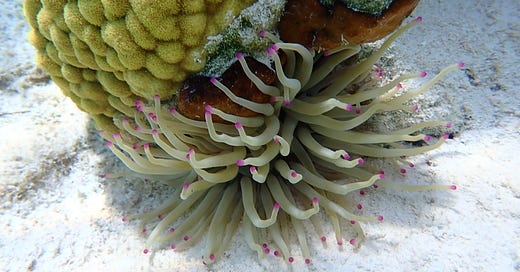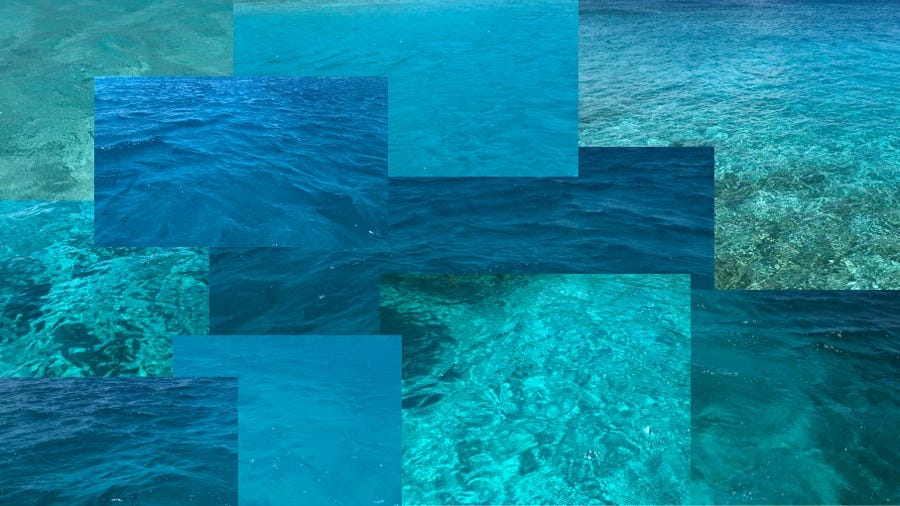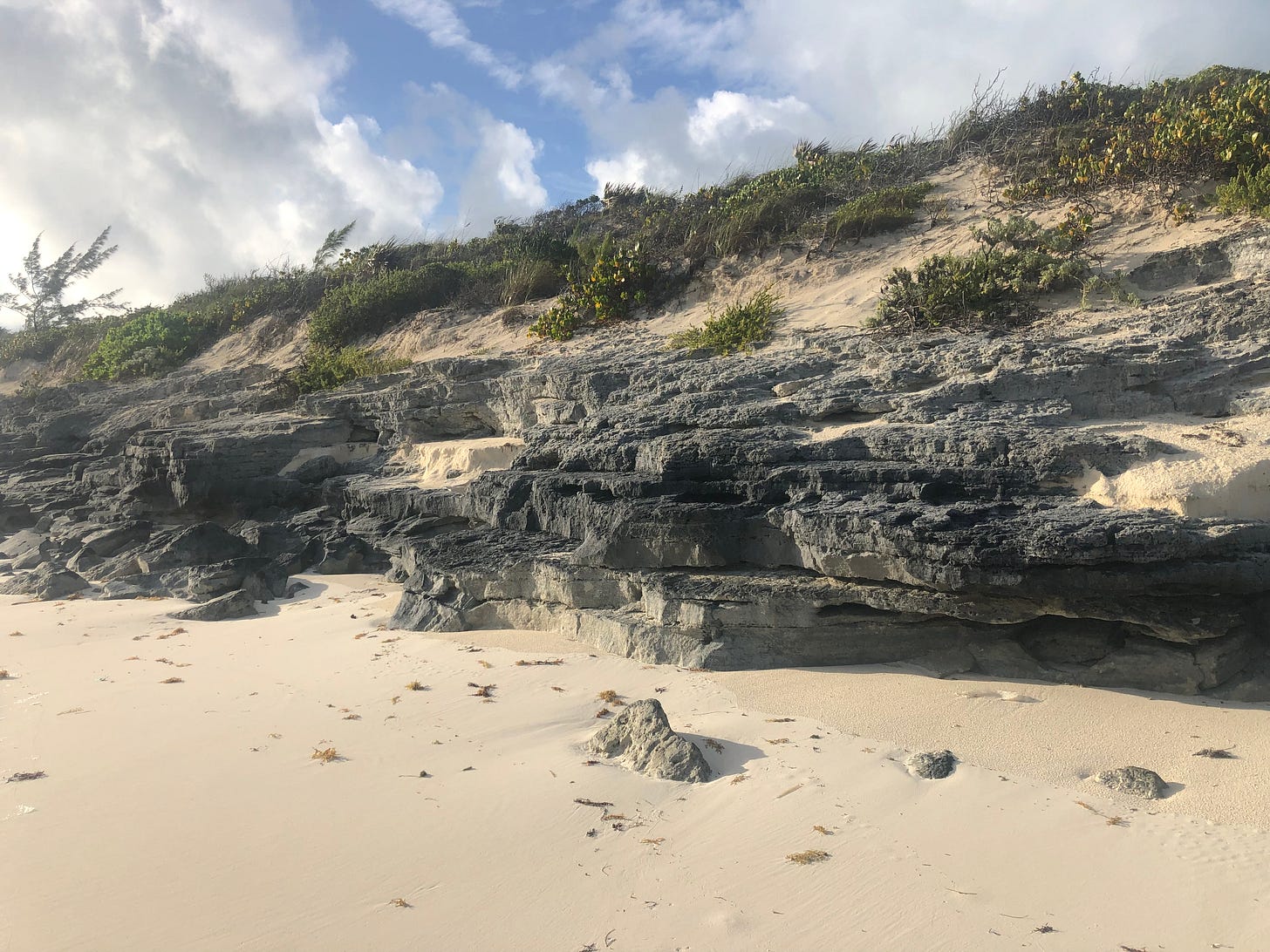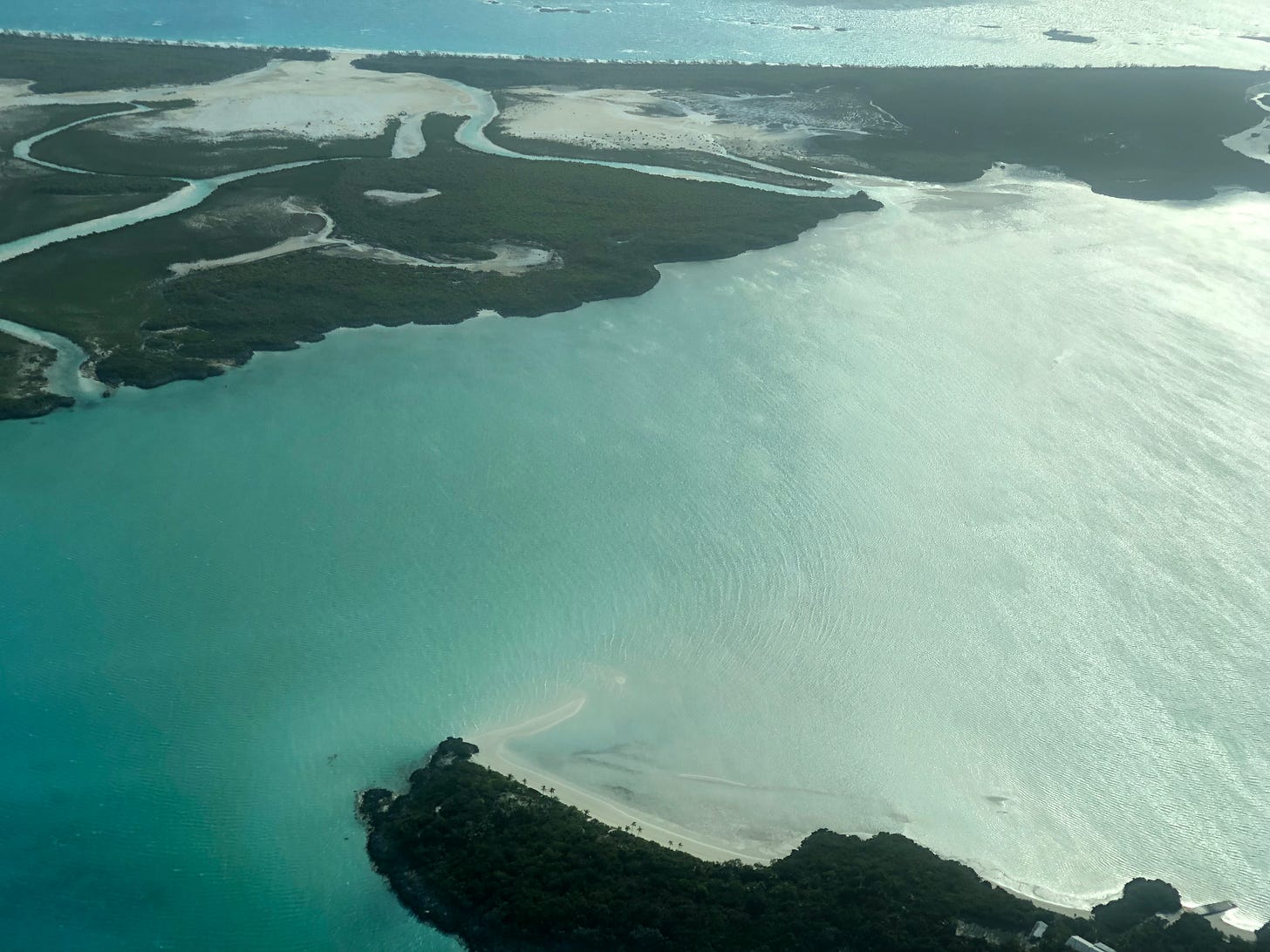In Want of a Geologist
When "parrotfish" isn't a complete answer to where the land came from
Close your eyes for a moment. There is a popping sound, a crackling. You are snorkeling on a Caribbean reef, and your ears are under water. Sound transmits differently in water than in air, but still—what is that sound?
With your eyes open the sound is audible too, but when the visuals go dark, it becomes dominant, impossible to ignore. Open your eyes and float and look and dive and search. There are so many unusual organisms here, it seems that any of them could be snapping and popping. Get lucky, though, while looking closely, and find the source of the sound. Parrotfish are banging their heads into the skeletons of dead coral, scraping off algae with their front teeth, which have fused into beaks.
There are many species of parrotfish, and none of them are neat eaters. Neither are their beaks precision tools, so the fish break off and ingest a considerable amount of dead coral along with the algae they are seeking. Coral skeleton is made of inorganic calcium carbonate, and parrotfish crack it off in such great quantities that it comprises nearly three quarters of their gut content. The specialized anatomy and physiology of parrotfish separates the dead coral that they can’t digest from the algae that they can, and they grind the coral grit into tiny bits. Those tiny bits are then released out the back ends of parrotfish into the reef as the substance that we call sand. I find the next bit hard to believe, but will report it nonetheless, as it comes from a source that I have come to trust: the processing of such large amounts of dead coral by so many individuals and species of parrotfish “generates much of the sand associated with tropical reefs and beaches.”1

Snorkeling is an experience of wonder and discovery, as is so much of wandering about the world, stumbling upon things that you did not previously know or expect. Sometimes, in such a state, you might find yourself out of ideas—you don’t know what you saw, or what it meant, and you don’t know how to figure it out. Sometimes, in such a state, you might find yourself in want of an expert.
Decades ago, when we were college students on a cross-country road trip, Bret and I found ourselves in the upper peninsula of Michigan. We had not yet lived in Michigan, nor were we familiar with its inhabitants. One night outside of our tent, very late, we saw something rustling in the underbrush. Or perhaps it scurried. Maybe it even lumbered. Truth be told, it has been so long that I do not remember what we actually saw. What I do remember is that we could not figure out what it might be. We narrowed it down to “mammal,” but could not get any more granularity on the diagnosis than that.
“What we need,” said one of us to the other, “is a mammalogist.”
And so it became part of our private dialogue, that sometimes, as inconvenient as it might otherwise be to have a whole other person tagging along on one’s adventures, what one really needed was a mammalogist.
Not too many years later, Bret would in fact become a mammalogist (a type of vertebrate zoologist who specializes in mammals, vertebrate zoologist being a subset of zoologist, zoologist being a subset of biologist). I would, around the same time, become a herpetologist, a type of zoologist who specializes in creepy crawly vertebrates2 or, to be a bit more scientific about it, amphibians and reptiles.
We have, over the years, sometimes again found ourselves in want of a mammalogist (or a herpetologist), preferably one who had rather a better fix than we did on the fauna local to a particular place that we were in—be it Panama or Madagascar, British Columbia or Turkey. Usually, though, we’ve been able to find our way through.
Last week, however, we found ourselves decidedly in want of a geologist.
For the first time in our lives, we were in the Bahamas. We are blessed with friends with an excess of both skill and generosity3, who invited us to join them on their boat for six nights, a boat they have been living and cruising on for nearly two months. Our time with them was spent moving between cays in the Exumas, an island chain I had never heard of before this year.
The islands of the Exumas number in the hundreds. Many of them are tiny and uninhabited by people, others are large enough to support small settlements. All of them are quite flat. Waves pound the easterly coasts of these islands, crashing on rocks and sand alike. On the westerly and southerly edges of the islands, the coasts and coves are more sheltered, and tidal creeks stream forth over the finest white sand imaginable. Some of the islands have abundant mangroves, as on Shroud Cay4, where the mangroves are dense but exquisitely short, stunted presumably due to the fierce winds that sometimes blow in off the Atlantic. Through the mangroves run shallow channels that are populated by sea turtles, small sharks, rays, and a wide variety of fish. Mangroves have evolved the capacity to grow where few other plants can5, and their roots trap sediment, such that they make land where once there was none.
The most magical parts of the Exumas are in and of the water, the shades of which are a seemingly infinite palette made entirely of blues and greens.
There are coral reefs here and there, patchy in amongst large swaths of sand and seagrass on the shallow seafloor. Many of the inhabitants of these reefs are so unlike what is found on land that it can be hard, even, to know what part of an organism you are looking at. The reef fish are comparatively easy to fathom for land-dwelling vertebrates such as ourselves, but still have lives far outside of our experience. There are, to name just a few, the abundant beaugregories, which often live in abandoned conch shells; tiny gobies, which act as cleaner fish for other species; angelfish, some species of which are protogynous hermaphrodites, meaning that they begin their lives as females, and may transform into harem-defending males later in life; needlefish, streamlined and nearly transparent, which glide along the very surface of the water so quickly that they come in and out of view; and of course those many species of parrotfish, turning dead coral into sand at an astonishing rate.6

These low-lying islands mark the edge of the Exuma bank, a vast area of many hundreds of square miles of crystal-clear waters, the sea floor rarely dipping more than thirty feet below the surface of the water, often much closer to the surface than that.
This shallowness, and the sandy sea floor, helps to explain the incredible color palette—palest green, aquamarine, teal, seafoam, azure, turquoise, cerulean, even, very occasionally, farther out, a deep radiant royal blue. But what explains the islands themselves?
One morning, while we were moored in the marina at Compass Cay, I walked across the island to the windward side to watch the sun rise. The tide was low, exposing very low cliffs that came down to the softest of sand beaches. Some of the land looked like limestone karst7, worn away by rain and erosion. This limestone could easily be the skeletons of millions of years of corals, now become land.
Adjacent to that, however, were stacked shelves of sand, except the sand was actually rock, indestructible and unbreakable. Until you touch it though, it looks just like crusty sand.
What then are these islands even made of?
I see the roots of mangroves collecting the stuff of the sea, turning it slowly into land. I know that corals become the foundation for more corals, and with enough time and pressure, those corals and other shelled creatures can become rock. And I hear the parrotfish nipping at some of those dead corals, clicking and clacking, popping and rasping, and passing them through their guts, pooping them out as sand.
But all of these explanations are inherently biological in nature. Is this just my biotic bias showing itself? I know so much more about the biotic than the abiotic world, that perhaps it is inevitable that I will lean towards such explanations. In general, it’s not the biota—the living world—that makes up our land. Soil is alive, yes, in so many ways, with so many organisms. But what lies beneath is abiotic—not alive. It’s rocks, in short, the stuff the Earth was made of before there was life here, and the rocks themselves are made of the stuff of the Universe, before there was an Earth.
You can see why I was in want of a geologist.
Lacking a geologist, and with only sporadic internet access, I found and downloaded just one paper before returning to our experiences in the moment: snorkeling among the reef fish and the occasional nurse shark or green sea turtle, being constantly astounded at the array of colors in the water and the sky, sharing good food and drink and conversation with friends.
In lieu of an actual geologist, a paper written by geologists would have to do.
Surficial and Shallow Subsurface Geology of the Northern and Central Exuma Cays, The Bahamas8 was written by two American scientists, who published it at the end of 2021 in the Caribbean Journal of Science. It’s a daunting enough title, and in the abstract—the summary before the paper that is generally more accessible than the paper itself—I found these two sentences:
The outcropping rocks throughout the Cays are characterized by a mix of nearly pure bioclastic and oolitic sediments and limestone units. Generally, the highstand limestone deposits are capped with lowstand terra rossa paleosols, red-stained micritic limestone, calcrete, or karst surfaces.
Ah. Well, as it turns out, I don’t speak geology. I do speak several (but hardly all) dialects of biology, but it’s not at all the same.
My next steps might be to do a more complete literature search, and perhaps to find my way in through non-primary papers to start. But I’m not going to learn how to speak geology this week. What I am left with is thinking, in broad terms, about continental shelves; and sea levels, both modern and historic; and the Jet Stream in the air, and the Gulf Stream in the water, as well as more local and transient currents; and vulcanism9; and to what degree biological realities like organisms ancient and recent breaking down and becoming limestone and mangroves trapping sediment and parrotfish making sand out of coral, can transform seascapes into landscapes.
For all I know there are very large factors that I have not begun to consider, in wondering what explains the islands of the Exumas. I chose not to google it, even in the last 48 hours, between leaving the Bahamas and publishing this here. I have only the one primary research paper, which I find largely unintelligible. One of the risks in adopting such a strategy—don’t look it up—is that those who are eager to play “gotcha” will find an answer that I have not and try to use that fact as a cudgel. I am actually fine with this, although I’m not sure why the would-be cudgel-bearers are. They are not demonstrating wisdom or skill or any kind of scientific capacity by so doing. What they are demonstrating is that a WEIRD10 person can look things up. And as Bret and I have argued elsewhere11, in a lot of situations, not looking things up is the best route to true knowledge.
I am fine with the risk in this strategy because the strategy itself bears so much fruit.
The strategy is: Observe, observe, and observe some more. Ask questions of yourself as you begin to interpret what you think it means. If others are observing the same things, ask questions of those people as well. Consider what you already know and apply it to what you are now seeing: Are the two consistent? If not, which thing is wrong: What you thought you already knew, or what you think you are currently seeing? Repeat and repeat and repeat, with more observations that overlap imperfectly—in this case, for instance, observations from a different island, or from a coast with a different orientation, or under different tidal conditions.
In this way we come to know deeply about our world, and also about how to come to know more deeply about it. It is a process—a strategy, to repeat my word from earlier—that creates more capacity and knowledge and even curiosity. The more you know, the more you realize how much there is still to understand.
The quick fix—just google it—brings little if any of those benefits. We tend to quickly forget the things that we look up on the spur of the moment. We develop no skills from doing so. We become no wiser in the ways of the world, nor in how our own brains process and interpret information. And we stand to lose touch with our own sense of awe.
All of that said, I am still in want of a geologist.
Next week, perhaps: On being a herpetologist in a land of curly tailed lizards.
The source on this claim is the field guide, Reef Fish Behavior: Florida, Caribbean, Bahamas, by Ned DeLoach, with photographer Paul Humann, published in 1999 by New World Publications. It is an excellent resource for those who want to know more about, for instance, how hammerhead sharks slam rays to the seafloor before taking a bite, among many other things.
From the Greek, herpein, meaning “to creep,” from which the word herpes also comes.
If I try to do justice to our friends Dave and Madeline Stephens here, honoring them as they deserve, I will fail. Here I will simply say: thank you. We are forever grateful.
The Shroud Cays lie within the vast Exuma Cays Land and Sea Park, established in 1958 and covering over 110,000 acres (175 square miles) of land and sea.
“Mangrove” is not a single lineage of plant, but an adaptive strategy for a problem (salty water) shared between many different lineages of plants, about which I wrote more here.
Again, see Reef Fish Behavior: Florida, Caribbean, Bahamas (from footnote #1)
Karst refers to a limestone landscape that has been eroded in such a way as to produce sharp and sculptural repeating surface formations. I know the term from experience in Ankarana in northern Madagascar, where limestone karst—tsingy—has collapsed in several places, creating a landscape that alternates between caves, through which you can walk to access otherwise wholly isolated pockets of forest, which are surprisingly replete with lemurs and chameleons and other endemic Malagasy organisms.
Hearty and Backstrom 2021. Surficial and Shallow Subsurface Geology of the Northern and Central Exuma Cays, The Bahamas. Caribbean Journal of Science, 51(2): 264-286.
These islands do not feel volcanic to me—something about their flatness and also how the rock feels and looks—but rather tectonic, but again, I am speaking as a biologist with little knowledge of geology.
WEIRD: of a person living in a country that is broadly Western, Educated, Industrialized, Rich, and Democratic.
We spoke at Colorado College’s first Symposium on Field Study in 2015; the Proceedings were published in 2016, including the paper we generated from our talk: Don’t Look It Up (not to be confused with the 2021 apocalyptic film Don’t Look Up).









Hey Heather,
I'm a H.S. Biology/Gen. Science teacher, but I have a BS in Geology from KU. Being from Kansas, marine sedimentary rocks are something we are rather used to studying, as the Bahamas look a lot like what Kansas looked like during the Pennsylvanian and Cretaceous periods (shallow marine ecosystem). Shallow marine ecosystems are characterized by sandstones/limestones. Deeper marine rocks are typically your mudstones/siltstones/shales.
To start, the ocean floor is made of is an igneous extrusive rock known as basalt, that forms in midocean ridges where ocean plates are pulling themselves apart. As that rock migrates away from the MOR due to convection currents below the crust, it accumulates sediment that is a mixture of very finely grained minerals and biotic content, which forms the sedimentary rock shale. This occurs in a deep ocean environment. As the ocean floor approaches continents, we see shallowing/sedimentation from continental material due to erosion/deposition of our fluvial systems (rivers) and wave action on the continent itself. If you look at a relief map of the southern US and the Bahamas, you can see that long shore drift (unidirectional erosion caused by waves) has carried sediment from the continent to the SE, forming the underwater peninsula that Florida and the Bahamas are a part of. This would likely mostly be sandstone, and would provide a shallow marine ecosystem to form those limestones/cross bedded sandstones. Keep in mind that 12kya, sea level was several hundred feet lower, and much of this area would've been above water, and before the last million years or so, it would've been about where it is today. Oscillating sea level will have different areas either exposed to the elements to form paleosol or karst, in shallow water to form limestones/sandstones, or in deep water forming shales/siltstones, depending on the time period whichever rock layer in question was being deposited.
My assumption based on what I'm able to read in the abstract/figures is that each island is probably somewhat unique depending on it's location within this marine setting, so each island will likely have a different sequence of rock, even if the general pattern remains for the region.
So, that all said, discussion on the rock types described in the paper you shared (again, I'm only able to see the abstract and figures).
Bioclastic/Oolitic limestones. Bio clastic just means life rock...essentially. It's just saying that the limestone formed from bits of dead sea creatures. Oolitic limestone is formed when concentrations of CaCO3 and the environmental conditions are primed for oolites to form. Oolites are precipitates that form little tiny spherical balls of CaCO3 that look like everlasting gobstoppers or hail stones. Typically a piece of sand works as the starting point, and then concentric layers of CaCO3 forms around that grain. This occurs in very warm, very shallow marine areas, like, well, the Bahamas. As life accumulates over time, so too does it's CaCO3, and you get a build up of that material on the ocean floor enough to form layers of rock.
Eolian cross bedded sandstones form above ground. Typically, eolian sandstones are formed in deserts and arid conditions, but in this case, likely the dunes beachside. Paleosols are ancient soils, calcite and karst surfaces form from erosion. Karst topography is a very special type of erosionary surface that occurs to limestone/dolomite. It's how caves and sinkholes form, as the rock dissolves in solution. These are all types of rock indicative of being exposed to the elements for long periods of time.
So, from what I can gather, due to continental erosion, this region is a shallow marine area. This set the stage for the buildup of organic material in the form of CaCO3 and limestone. As sea levels lowered, it would expose the the shallower areas and you would get paleosol/karst form. As sea level rose, limestones/sandstones would once again build. This was likely an oscillating buildup of erosion/deposition over 10s of millions of years.
Not being an expert in the region, I can't give you too many more specifics than that, but that's the more general explanation.
I too have had the opportunity to snorkel in the Caribbean - such a wide array of spectacular sights! But your story has me laughing at my own experience birding just yesterday. We have white-throated sparrows on our property and I noticed a color variation which I presumed to be gender-related (think cardinals, mallards, heck nearly every duck where the male has much more attractive plumage). So I googled it 🤦 and was pleasantly surprised to find out that the color variations occur in both sexes and is more indicative of an aggressive/territorial behavior (hey, I'll make sure our nest is secure) versus a more nurturing behavior (hey, I'll make sure the kids get fed). Typically they form mating pairs with opposite color patterns which works well, but sometimes they are left with only a similar colored mate and their family raising efforts are less than ideal. So not what I was expecting ... in fact, it was such the opposite of what I was expecting that I shall never forget it. Or maybe, I was just intrigued to learn about something other than Covid?
But I whole-heartedly agree with your recommendation to spend time outside just observing and asking questions (such a completely worth-while endeavor which sadly is overlooked in our modern concrete world). I truly do enjoy marveling at what is known while still being cognizant of the much greater unknown.